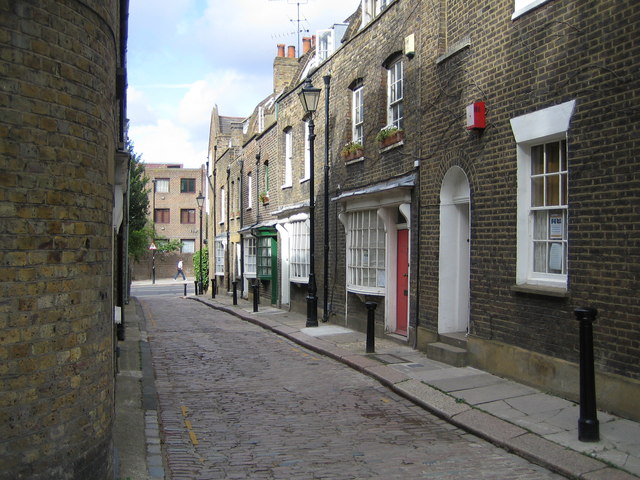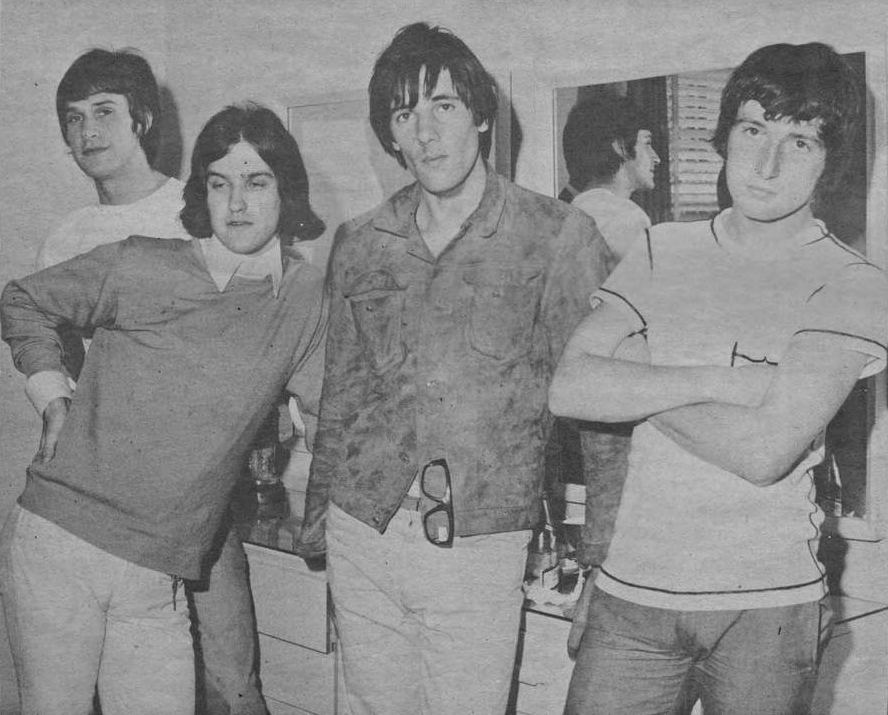|
Dead End Street (song)
"Dead End Street" is a song by the British band the Kinks from 1966, written by main songwriter Ray Davies. Like many other songs written by Davies, it is to some degree influenced by British Music Hall. The bass playing was partly inspired by the "twangy" sound of Duane Eddy's guitar. It was originally released as a non-album single, but has since been included as one of several bonus tracks from the '' Face to Face'' CD. The song, like many others by the group, deals with the poverty and misery found in the lower classes of English society. Background According to Ray Davies, the lyrics are about a couple that want to emigrate to Australia under the Assisted Passage Migration Scheme but when that fell through they could not get a job. Describing the song in his 1996 autobiography, ''Kink'', Dave Davies said: "'Dead End Street' was the epitome, to me, of what the Kinks were all about. A song full of character, pathos, yet containing an underlying sense of hope. Reflecting a ... [...More Info...] [...Related Items...] OR: [Wikipedia] [Google] [Baidu] |
The Kinks
The Kinks were an English rock band formed in Muswell Hill, north London, in 1963 by brothers Ray and Dave Davies. They are regarded as one of the most influential rock bands of the 1960s. The band emerged during the height of British rhythm and blues and Merseybeat, and were briefly part of the British Invasion of the United States until their touring ban in 1965. Their third single, the Ray Davies-penned "You Really Got Me", became an international hit, topping the charts in the United Kingdom and reaching the Top 10 in the United States. The Kinks' music drew from a wide range of influences, including American R&B and rock and roll initially, and later adopting British music hall, folk, and country. The band gained a reputation for reflecting English culture and lifestyle, fuelled by Ray Davies' wittily observational writing style, and made apparent in albums such as '' Face to Face'' (1966), '' Something Else'' (1967), ''The Village Green Preservation Society'' (1968), ... [...More Info...] [...Related Items...] OR: [Wikipedia] [Google] [Baidu] |
Dave Davies
David Russell Gordon Davies (born 3 February 1947) is an English guitarist, singer and songwriter. He was the lead guitarist and backing vocalist for the English rock band the Kinks, which also featured his elder brother Ray Davies. He was inducted into the Rock and Roll Hall of Fame in 1990 as a member of the Kinks. Davies is prolific with his innovative nature on the electric guitar, specifically in being one of the first to utilize electric guitar distortion and exposing the effect to the mainstream. His signature distorted power chord riffs on songs would heavily influence future heavy metal and punk rock acts. In 2003, Davies was ranked 91st in ''Rolling Stone'' ''Magazines list of the " 100 Greatest Guitarists of All Time". Early life David Russell Gordon Davies was born at 6 Denmark Terrace, Muswell Hill, North London. He was born the last of eight children, including six elder sisters and an elder brother, later bandmate Ray. As children, the Davies brothers were im ... [...More Info...] [...Related Items...] OR: [Wikipedia] [Google] [Baidu] |
Kentish Town
Kentish Town is an area of northwest London, England in the London Borough of Camden, immediately north of Camden Town. Less than four miles north of central London, Kentish Town has good transport connections and is situated close to the open spaces of Hampstead Heath. Toponymy The name of Kentish Town is probably derived from ''Ken-ditch'' or ''Caen-ditch'', meaning the "bed of a waterway" and is otherwise unrelated to the English county of Kent. In researching the meaning of ''Ken-ditch'', it has also been noted that ''ken'' is the Celtic word for both "green" and "river", while ''ditch'' refers to the River Fleet, now a subterranean river. However, another theory is the name comes from its position near the Fleet; it has been suggested that Kentish Town, which lies in between two forks of the Fleet, takes its name from ''cant'' or ''cantle'' (from the Middle English meaning "corner"). History Kentish Town was originally a small settlement on the River Fleet (the waterwa ... [...More Info...] [...Related Items...] OR: [Wikipedia] [Google] [Baidu] |
Little Green Street
Little Green Street is an 18th-century street in London, located off Highgate Road in Tufnell Park. Location The street is located in Tufnell Park, part of the London Borough of Camden, and is next to the B518 and the Gospel Oak to Barking train line. It is also on Bus route 88 and route 214, being a short distance from stops on both routes. History The street is diminutive, with only eight houses on one side and two on the other. The houses were built in the 1780s, are Grade II listed, and remain one of the few intact Georgian streets in London. There are records of the small, bow-fronted shops selling ribbons and mousetraps, and previous inhabitants include manual workers such as carpenters. One of the first official mentions of Little Green Street is in the court records of the Old Bailey for 10 July 1805, where Mary Lee, a female servant was fined and sent to the Clerkenwell House of Correction for "simple grand larceny" (theft under 40 s). Almost a century later, in 18 ... [...More Info...] [...Related Items...] OR: [Wikipedia] [Google] [Baidu] |
Music Video
A music video is a video of variable duration, that integrates a music song or a music album with imagery that is produced for promotion (marketing), promotional or musical artistic purposes. Modern music videos are primarily made and used as a music marketing device intended to promote the sale of Music Recording, music recordings. Although the origins of music videos date back to musical short, musical short films that first appeared, they again came into prominence when Paramount Global's MTV based its format around the medium. These kinds of videos were described by various terms including "illustrated song", "filmed insert", "promotional (promo) film", "promotional clip", "promotional video", "song video", "song clip", "film clip" or simply "video". Music videos use a wide range of styles and contemporary video-making techniques, including animation, live action, live-action, documentary film, documentary, and non-narrative approaches such as Non-narrative film, abstract fi ... [...More Info...] [...Related Items...] OR: [Wikipedia] [Google] [Baidu] |
New Musical Express
''New Musical Express'' (''NME'') is a British music, film, gaming, and culture website and brand. Founded as a newspaper in 1952, with the publication being referred to as a 'rock inkie', the NME would become a magazine that ended up as a free publication, before becoming an online brand which includes its website and radio stations. As a 'rock inkie', ''NME'' was the first British newspaper to include a singles chart, adding that feature in the edition of 14 November 1952. In the 1970s, it became the best-selling British music newspaper. From 1972 to 1976, it was particularly associated with gonzo journalism then became closely associated with punk rock through the writings of Julie Burchill, Paul Morley, and Tony Parsons. It started as a music newspaper, and gradually moved toward a magazine format during the 1980s and 1990s, changing from newsprint in 1998. The magazine's website NME.com was launched in 1996, and became the world's biggest standalone music site, with ... [...More Info...] [...Related Items...] OR: [Wikipedia] [Google] [Baidu] |
Cash Box
''Cashbox'', also known as ''Cash Box'', was an American music industry trade magazine, originally published weekly from July 1942 to November 1996. Ten years after its dissolution, it was revived and continues as ''Cashbox Magazine'', an online magazine with weekly charts and occasional special print issues. In addition to the music industry, the magazine covered the amusement arcade industry, including jukebox machines and arcade games. History Print edition charts (1952–1996) ''Cashbox'' was one of several magazines that published record charts in the United States. Its most prominent competitors were '' Billboard'' and '' Record World'' (known as ''Music Vendor'' prior to April 1964). Unlike ''Billboard'', ''Cashbox'' combined all currently available recordings of a song into one chart position with artist and label information shown for each version, alphabetized by label. Originally, no indication of which version was the biggest seller was given, but from October 25, 19 ... [...More Info...] [...Related Items...] OR: [Wikipedia] [Google] [Baidu] |
Billboard (magazine)
''Billboard'' (stylized as ''billboard'') is an American music and entertainment magazine published weekly by Penske Media Corporation. The magazine provides music charts, news, video, opinion, reviews, events, and style related to the music industry. Its music charts include the Hot 100, the 200, and the Global 200, tracking the most popular albums and songs in different genres of music. It also hosts events, owns a publishing firm, and operates several TV shows. ''Billboard'' was founded in 1894 by William Donaldson and James Hennegan as a trade publication for bill posters. Donaldson later acquired Hennegan's interest in 1900 for $500. In the early years of the 20th century, it covered the entertainment industry, such as circuses, fairs, and burlesque shows, and also created a mail service for travelling entertainers. ''Billboard'' began focusing more on the music industry as the jukebox, phonograph, and radio became commonplace. Many topics it covered were spun-off ... [...More Info...] [...Related Items...] OR: [Wikipedia] [Google] [Baidu] |
Melody Maker
''Melody Maker'' was a British weekly music magazine, one of the world's earliest music weeklies; according to its publisher, IPC Media, the earliest. It was founded in 1926, largely as a magazine for dance band musicians, by Leicester-born composer, publisher Lawrence Wright; the first editor was Edgar Jackson. In January 2001, it was merged into "long-standing rival" (and IPC Media sister publication) ''New Musical Express''. 1950s–1960s Originally the ''Melody Maker'' (''MM'') concentrated on jazz, and had Max Jones, one of the leading British proselytizers for that music, on its staff for many years. It was slow to cover rock and roll and lost ground to the ''New Musical Express'' (''NME''), which had begun in 1952. ''MM'' launched its own weekly singles chart (a top 20) on 7 April 1956, and an LPs charts in November 1958, two years after the ''Record Mirror'' had published the first UK Albums Chart. From 1964, the paper led its rival publications in terms of approac ... [...More Info...] [...Related Items...] OR: [Wikipedia] [Google] [Baidu] |
Bass Guitar
The bass guitar, electric bass or simply bass (), is the lowest-pitched member of the string family. It is a plucked string instrument similar in appearance and construction to an electric or an acoustic guitar, but with a longer neck and scale length, and typically four to six strings or courses. Since the mid-1950s, the bass guitar has largely replaced the double bass in popular music. The four-string bass is usually tuned the same as the double bass, which corresponds to pitches one octave lower than the four lowest-pitched strings of a guitar (typically E, A, D, and G). It is played primarily with the fingers or thumb, or with a pick. To be heard at normal performance volumes, electric basses require external amplification. Terminology According to the ''New Grove Dictionary of Music and Musicians'', an "Electric bass guitar sa Guitar, usually with four heavy strings tuned E1'–A1'–D2–G2." It also defines ''bass'' as "Bass (iv). A contraction of Double bas ... [...More Info...] [...Related Items...] OR: [Wikipedia] [Google] [Baidu] |
Trombone
The trombone (german: Posaune, Italian, French: ''trombone'') is a musical instrument in the Brass instrument, brass family. As with all brass instruments, sound is produced when the player's vibrating lips cause the Standing wave, air column inside the instrument to vibrate. Nearly all trombones use a telescoping slide mechanism to alter the Pitch (music), pitch instead of the brass instrument valve, valves used by other brass instruments. The valve trombone is an exception, using three valves similar to those on a trumpet, and the superbone has valves and a slide. The word "trombone" derives from Italian ''tromba'' (trumpet) and ''-one'' (a suffix meaning "large"), so the name means "large trumpet". The trombone has a predominantly cylindrical bore like the trumpet, in contrast to the more conical brass instruments like the cornet, the euphonium, and the French horn. The most frequently encountered trombones are the tenor trombone and bass trombone. These are treated as trans ... [...More Info...] [...Related Items...] OR: [Wikipedia] [Google] [Baidu] |
French Horn
The French horn (since the 1930s known simply as the horn in professional music circles) is a brass instrument made of tubing wrapped into a coil with a flared bell. The double horn in F/B (technically a variety of German horn) is the horn most often used by players in professional orchestras and bands, although the descant and triple horn have become increasingly popular. A musician who plays a horn is known as a list of horn players, horn player or hornist. Pitch is controlled through the combination of the following factors: speed of air through the instrument (controlled by the player's lungs and thoracic diaphragm); diameter and tension of lip aperture (by the player's lip muscles—the embouchure) in the mouthpiece; plus, in a modern horn, the operation of Brass instrument valve, valves by the left hand, which route the air into extra sections of tubing. Most horns have lever-operated rotary valves, but some, especially older horns, use piston valves (similar to a trumpet's ... [...More Info...] [...Related Items...] OR: [Wikipedia] [Google] [Baidu] |





.jpg)



